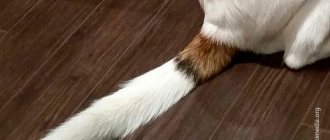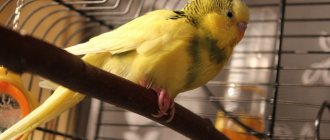A dog's tail is, as it were, an extension of its spine and consists of bones and muscles that allow the dog to move it in any direction and control the movement of the tailbone.
The dog uses its tail to perform complex maneuvers such as turning while running, jumping, climbing and descending, and walking on narrow surfaces. Waterfowl dogs have thick and strong tails, which help the dog stay in the water while swimming and change its trajectory in the water. Northern breeds of dogs have fluffy tails in severe frosts that help cover their heads and muzzles during sleep and rest.
At the base of a dog’s tail there is a gland that emits a specific odor characteristic of the dog. With the help of this smell, dogs on a walk get to know each other; when a dog is happy, it actively wags its tail, spreading its smell. At the same time, when frightened, she pinches her tail between her legs, reducing the spread of her scent.
A dog's tail is a tool for communication with both the owner and the animal world around the dog. If a dog wags its tail, it means that it feels safe and is ready to play and make friends. At the same time, a tucked tail indicates that the dog is scared, and may also indicate that it has a disease.
What does it mean if a dog begins to tuck its tail?
A dog’s tail is an important tool for communication and signaling to the owner about the well-being and state of the animal’s nervous system.
At its base there is a gland that emits a special smell, by the way, thanks to this factor, animals get to know each other. When the pet is in a joyful mood, he wags it, but if he is scared, he squeezes it between his paws, thereby reducing the degree of spread of his personal smell.
There are many reasons why a four-legged friend puts his tail between his legs.
There are physiological and pathological causes. Important! The tail is also necessary to maintain balance.
Congenital disorders
Most purebred dogs are prone to a number of hereditary diseases . Outbred animals are considered healthier because their gene pool is controlled by natural selection. Some breeds of four-legged animals are characterized by congenital disorders of the bone structure , while in others, ailments manifest themselves in childhood, adolescence or old age.
If the puppy tucks his tail because he cannot carry it any other way, the problem is in the spine and, most likely, it is congenital. The reasons are always the same, they can be divided into three types: gene mutation, thoughtless breeding, individual characteristics.
In the first place is thoughtless breeding, since the selection of sires for procreation is carried out according to a wide range of criteria. It just so happens that many people do not consider it necessary to think about what genetic abnormalities may appear in puppies. In the simplest cases, puppies will not have any abnormalities that affect their quality of life.
A kinked tail is a deformity of the spine due to the fusion of two or more vertebrae. The dog's tail must be flexible, since between the vertebrae there are nerve endings, and in them lies a canal with the spinal cord. If the spinal nerves are pinched during fusion of the vertebrae, the tail partially loses mobility. Perhaps the development of increased muscle tone, that is, they are always in a tense or compressed state.
Important! In some animals, a crooked tail causes more noticeable problems. For example, the dog hunches when walking or cannot sit down completely.
Do not buy an animal without a pedigree and be careful when choosing a puppy! Contact only officially registered breeders. Litters from breeding animals are inspected for defects before sale. If the puppy has deviations, appropriate notes are made about this in the documents.
What to do if the reason lies in fear
Even the largest and most formidable dog experiences a feeling of fear throughout its life. Most often it envelops him on the street, especially in an unfamiliar place, surrounded by other animals. In this situation, the owner needs to try to socialize his pet and show him that there is simply no reason for a panic attack.
To this end, you need to find owners with friendly dogs so that the dog gradually gets used to communicating with his relatives. For acquaintance, it is better to choose parks or forests where there are no loud sounds that could frighten the animal. When the dog gets used to the environment, you can gradually choose other, noisier areas for walking.
Important! If the dog is afraid and trembles noticeably, there is no need to scold or shake it, otherwise it may become aggressive.
A pet cannot be scolded for such behavior; on the contrary, every effort must be made to eradicate it
Hormonal and nutritional problems
The causes of tremors in pets may lie in hormonal imbalances in the animal’s body: during estrus in females and rutting in males, excitability increases. The problem resolves with the end of this period, and if desired, it can be eliminated by castration.
Often, animals whose diet has changed or are taking medications have an allergic reaction to new foods and medications, which can also cause trembling. This reaction is also caused by poisoning, which in addition to trembling is accompanied by nausea, vomiting, diarrhea, apathy, and lethargy.
Foods or medications that cause such phenomena should be excluded from the diet, and if necessary, antihistamines should be given and the animal should be shown to a veterinarian.
Physiological reasons
If such a pet’s behavior is associated with physiological signs, then it will disappear immediately, as soon as the irritating factor is removed.
Often the cause may be banal hypothermia of the body. The condition is characterized by chills. Also, pets may shake after water treatments if the room temperature is low.
In some cases, a dog may hold its tail and shiver slightly when experiencing hypoglycemia. The disease is caused by a decrease in blood sugar levels.
When a dog presses its tail, begins to twitch and looks lethargic, you need to pay attention to its general condition. This behavior may indicate illness, for example:
- poisoning;
- toothache;
- gastrointestinal diseases;
- disease of the circulatory system.
Important! For some breeds, such as the German Shepherd or Greyhound, a tucked tail is the norm in many situations.
If the owner suspects that his pet is sick, and tail pressing is only a symptom, he needs to contact a veterinarian
Chronic, sudden pain
Pet lameness is divided into chronic and sudden. It all depends on the time the first signs appear. The division already offers potential causes of suffering for owners.
Chronic lameness appears slowly, with symptoms gradually increasing in severity. Often associated with chronic inflammation, disorders of the anatomical structure of joints, ligaments, and other structures of the musculoskeletal system.
Sudden pain occurs quickly, as a result of injury. They are often a cause of concern for the owner when the pet moves. There are situations when daily jumping from the bed causes the manifestation of an existing injury, a sudden deterioration in the dog’s physical condition.
Psychological reasons for a dog with its tail between its legs
A healthy, relaxed animal will never tuck its tail between its legs. This position is unnatural for a pet and indicates psychological tension, fear or stress. Most often, a dog has a drooping tail due to the following reasons:
- The dog met a larger individual on the street, whose appearance instills fear in him. For this purpose, the dog tucked its tail to reduce the level of personal odor.
- Unfamiliar surroundings. In this case, you can notice additional signs, for example, a frightened look, a pressed ear, or the dog begins to whine altogether.
- Wrong upbringing. In this case, we are talking about regular physical punishment that the owner used from puppyhood. Pressing here is nothing more than a developed reflex.
- The dog tries to hide important reproductive organs and the abdominal area if it feels threatened.
Important! Only the love and care of the owner will help you get rid of any of the psychological reasons.
Forms of myositis: a brief overview
Taking into account the clinical picture and the area of muscle damage, different forms of myositis are distinguished. The most common among dogs include:
Traumatic. The main sign of traumatic myositis in dogs is slow and sluggish movements. The pet is careful, but does not move well. It is noticeable that he is trying to protect the affected area. Additional symptoms include lack of appetite and the appearance of lumps (swelling) in the area of muscle tissue. They may differ in size, but when you touch them, your pet experiences severe pain. The muscle that has been damaged as a result of the disease increases in volume and becomes more tense.
Purulent (infectious) . It is distinguished from other types of myositis by the fact that an infectious pathogen (rickettsia, streptococci, etc.) penetrates into the damaged area. Specific symptoms of purulent myositis include high body temperature of the animal and an abscess, i.e. purulent inflammation of tissues and the appearance of a purulent cavity. This is the most dangerous form of myositis, as it can trigger the development of sepsis. Additional symptoms include lethargy, depression, and minimal mobility.
Rheumatic . In more than 85% of cases, the factor causing this form of myositis in dogs is hypothermia. The disease is often diagnosed in pets kept outdoors even in the winter (for example, in a cold enclosure or on a chain). Hypothermia of the body leads to the development of an inflammatory reaction, which can spread to neighboring areas of the body. This form of the disease is accompanied by severe pain. Even simply touching the affected area causes extreme stress in the animal.
Eosinophilic . Unfortunately, the causes of this form of myositis have not been studied. It is known that it is of an autoimmune nature, and therefore it is often classified as a hereditary disease. The main feature of eosinophilic myositis is damage to the jaw muscles, which is why it is often called masticatory myositis in dogs. This condition is accompanied by convulsive tension and swelling of the muscles. Characteristic signs include hyperemia of the conjunctiva of the eye.
A small dog tucks its tail and trembles
Small breeds of dogs have a more sensitive nervous system than large ones. That is why they are more nervous and more susceptible to stress. If your four-legged friend has his tail between his legs, it means he doesn’t feel safe.
The cause of anxiety may be memories from the past or recent impressions that have traumatized the psyche. Remembering them, she may begin to worry and whine, and subsequently tuck her tail and tremble. If the pet is overcome by a fit of trembling, and he presses his tail only in the presence of strangers, even those who came to the owner’s house, this indicates a low level of socialization.
Many representatives of small breeds are afraid of thunder, lightning and knocking - this phenomenon, if it is short-term, is not a cause for concern.
Small dogs are more susceptible to stress, hence this behavior.
Restless behavior as a sign of illness
Often the dog behaves restlessly due to the influence of so-called internal stress factors. That is, due to poor health, health problems.
Restless behavior as a sign of disease in dogs is noted when:
- neuroses, nervous disorders, pathologies;
- viral-bacterial, parasitic infections, which are accompanied by damage to the central and peripheral nervous system;
- renal colic;
- chronic, acute renal, liver failure;
- allergic manifestations (food allergies);
- disturbances in the gastrointestinal tract (acute intestinal disorder, food poisoning, chemicals, gastric volvulus);
- inflammation, blockage of the paraanal glands.
The dog may experience anxiety due to helminthic infestation, mycoses, dermatitis, dermatoses, or due to infection with ectoparasites.
Reasons why a dog tucks its tail and hunches
If a dog tucks its tail and humps, this is a fairly serious sign. This behavior may indicate deformation of 2-3 vertebrae.
The pathology can be congenital or acquired. The first is related to breeding. A puppy's drooping tail may be a sign of gene mutations or fusion of the vertebrae, as a result of which he begins to hunch his back.
Important! In some cases, this may only be an aesthetic drawback that does not at all interfere with the normal functioning of the dog. But, still, if your four-legged friend is hunched over, he should be shown to the veterinarian.
Acquired pathologies can arise due to injury, illness or age of the four-legged friend.
If the dog not only presses its tail, but also hunches over, this may indicate problems with the spine.
Treatment methods
Approximate treatment plan
Fracture
Surgery to place pins and plates to help the bone heal properly. After a month, the dog gets up on its paws and begins to lead an active life.
In case of damage to the peripheral nerves of the spinal column
Drugs are prescribed to stimulate the restoration of nerve tissue. As a rule, treatment takes a long time due to the nature of fiber regeneration.
Tumors and intervertebral hernia
Depending on the size of the pathology, surgery is performed.
Osteochondrosis
Successfully treated at different stages. Therapy is complex and lifelong.
Appointed:
- Dietary therapy to maintain healthy joints from a line of professional animal feeds
- Chondroprotectors – for restoration of cartilage tissue
- B vitamins - as a rule, the drug Combilipen is used
- Nonsteroidal anti-inflammatory drugs
- Physiotherapeutic procedures - warming with a blue lamp
- Massage if the disease was detected at an early stage.
Treatment is long and complex and always comprehensive
Spondylosis
It is treated with lifelong use of NSAIDs and various methods of physical therapy, for example, acupuncture at certain points and acupressure. In case of calcification of the ligaments, lipase injections are prescribed.
Discopathy
In the early stages, NSAIDs are used. In advanced cases, surgical intervention.
Necessary actions
The first thing the owner must do is to understand the reasons for this behavior of his four-legged friend. It’s worth watching him for a while and noticing in what situations he behaves this way:
- when he feels guilty;
- scared;
- feels bad.
If the animal is frightened of something or begins to rush from place to place, it is necessary to create a quiet and calm environment and observe whether its behavior changes. However, it is highly undesirable to drop everything you are doing, hold the animal close to you and calm it down, because it may regard the owner’s affection as encouragement from the owner. In this case, the dog will bend its tail on every occasion, and then wait for approval and affection from the owner.
When frightened, it is worth switching the attention of your four-legged pet in order to relieve him of his worries.
If the animal behaves in a similar way, but the situation with fear or a bad act is excluded, then the reason lies in its health. In this case, the animal should be shown to a veterinarian.
If a pet is stressed, then the care and love of the owner will be the best medicine
Possible complications
If you do not seek veterinary help in time (or do not diagnose the disease correctly), the inflammation will continue to develop and begin to affect nearby areas of the body. In this case, it will be almost impossible to stop the inflammatory process without consequences. Complications that are possible with myositis in dogs include:
- weakening of one or several muscles at once, up to complete death (in which case they cease to perform their functions);
- further spread of the infectious disease and the occurrence of abscesses (purulent lesions);
- change in size of one or more damaged muscles - they become deformed and become noticeably shorter;
- Deterioration of vision in an animal is one of the common consequences of eosinophilic myositis.
Diseases that lead to “tail tucking”
Some diseases in animals lead to the fact that they begin to pick up their tail, which is one of the symptoms.
Hypoglycemia is low blood sugar. The disease is manifested by a decreased level of appetite or, on the contrary, a high need for calories, weakness and apathy, high levels of salivation, and fever. With hypoglycemia, the dog sits down as if completely deprived of strength. The attack ends with a decrease in body temperature, convulsions, lethargy, the dog stops breathing, resulting in death.
Important! If symptoms are detected, the owner should give the pet sweet water or glucose and go to the veterinary clinic.
In addition, such behavior can be associated with the following diseases:
- Anemia is a very serious disease associated with low levels of red blood cells and hemoglobin in the blood.
- Discopathy is a disease of intervertebral discs, which is accompanied by their mixing and destruction.
- Poisoning. When poisoned, a four-legged friend not only tucks his tail under himself, but also refuses to eat, he experiences active salivation, vomiting, lethargy and diarrhea.
- Toothache or headache. As for toothache, in this case we are talking about caries.
There are many diseases for which this behavior is a symptom, but for diagnosis you should contact a veterinary clinic
Causes of hind leg failure in dogs
- Damage to the peripheral nerves of the spinal column.
- Intervertebral hernia.
- Spondylosis.
- Paw injuries.
- Tumors.
- Osteochondrosis.
- Discopathy.
All these pathologies can lead to complete or partial paralysis of the hind legs, weakness and lethargy.
A little more about these pathologies.
X-ray - failure of the hind limbs of a dog
Damage to peripheral nerves of the spinal column
This happens if the dog has a history of a gunshot wound, beating the animal in the back area, when hematomas compress the nerves and prevent them from freely transmitting impulses to the pelvic limbs and the paws may fail.
The process is reversible. After recovery is completed, the animals regain the ability to move, unless there has been serious damage to the spinal column.
As an additional therapy, if the examination did not reveal any third-party pathologies, a paw massage is performed so that after the nerves are restored, the dog can stand on its paws faster and more confidently.
Arthritis is a common cause of limb mobility impairment.
Intervertebral hernia
Intervertebral hernia is observed in dogs with a long spine - corgis and dachshunds.
Corgis, dachshunds, and German shepherds have large distances between the vertebrae, which leads to prolapse. The fibrinous ring, under the influence of various factors, shifts beyond the boundaries of the vertebral disc, dragging the nucleus pulposus with it. Nerves are compressed.
The process is developing slowly. Often seen in older dogs.
You can tell that a dog is suffering from a hernia by the following signs:
- She lies in an unusual position for her and cannot walk.
- Refuses active games, lethargic.
- At first the hind legs give way, the dog falls, becomes weak, and feels unwell. Complete paralysis appears some time after the onset of the disease.
- When touched to the back (usually the lumbar region) it shows that it is sick.
In advanced cases, it can only be treated with surgery.
It happens that only the fibrinous ring protrudes beyond the vertebral disc, without dragging the nucleus along with it. With this pathology, paralysis of the pelvic limbs does not develop, but the gait becomes unsteady and unsure.
A characteristic sign of the disease is stiffness of movement after sleep or long rest.
Spondylosis
The disease is characterized by aging of individual vertebrae. 1-3 may suffer, and the rest remain unchanged. The fibrinous egg is affected without affecting the nucleus pulposus. The process proceeds slowly, not manifesting itself in any way until the last stage, when the longitudinal ligament calcifies. At this stage, paresis and paralysis of the pelvic limbs develop.
Paw injuries
These include:
- Dislocations.
- Various fractures and legs may be lost.
- Sprained and torn ligaments, the dog pulls its paws behind itself.
- Inflammation of ligaments and tendons.
Hind limb injury
Everything occurs as a result of trauma that the animal receives during active games, falls and blows.
A characteristic feature of injury is acute pain in the affected area.
Tumors
New growths near or in the spinal cord lead to compression of the nerve tissue and swelling, which prevent the transmission of impulses to the hind legs.
In addition to paralysis of the limbs, the following symptoms appear:
- Refusal to eat.
- Urinary and fecal incontinence.
- There is exhaustion.
- The dog arches its back.
The only possible treatment is removal of the tumors.
Chemotherapy drugs are rarely available for animals.
Osteochondrosis
Damage occurs not only to the vertebral discs, but also to the ligamentous apparatus. Depending on the location of the lesion, different symptoms are observed.
The dog lies down a lot, stops running and playing, gets up reluctantly and slowly
Throughout the entire period of illness, the animal shows in every possible way that something is bothering it. She may lie uncharacteristically, move little, and whine if the affected area is touched.
Osteochondrosis develops slowly, and the limbs begin to fail only at the last stage.
Discopathy
Bulldogs are susceptible. The essence of the disease is that due to the large distance between the vertebrae, the ligamentous apparatus weakens. The vertebra descends, injuring the spinal cord.
With discopathy in dogs, the paws suddenly fail.
The disease is hereditary. Common in the following breeds:
- French bulldogs.
- Dachshunds.
- Corgi.
- Pekingese.
- Brabançons.
When to contact a veterinarian
A loving owner, having discovered this factor, wonders why the dog does not raise its tail. However, not everyone tries to take their pet to the veterinarian, preferring to guess the reasons for this behavior on their own or deciding that the dog’s tail hurts and will go away with time.
If the pet begins to press its host under itself, it must be shown to a specialist. The veterinarian will conduct an examination and indicate the reasons why the dog’s tail is drooping, as well as prescribe treatment and explain how and why to care for your four-legged pet. It is not recommended to take measures to normalize the situation on your own, as you could harm the dog.
A loving owner must understand that a healthy dog in a good mood will never tremble or tuck its tail. Having discovered these signs, it is worth understanding the cause of their occurrence and, if necessary, taking all necessary measures to eliminate them.
How is the diagnosis done?
Diagnosis of myositis includes a complete physical (general examination, assessment of the condition of the skin, etc.) and neurological examination. The veterinarian will examine the oral cavity if the masticatory muscles are damaged. Additionally, a medical history is taken to exclude injuries that could cause the development of the disease.
To make an accurate diagnosis, different methods are used:
- laboratory testing of blood and urine;
- chest x-ray;
- Ultrasound of the abdominal area;
- tests for the presence of an infectious pathogen;
- biopsy;
- cytological examination, etc.
It is impossible to make a diagnosis on your own and at home. Myositis in dogs requires contacting a veterinarian, so do not risk the health and life of your pet - entrust the diagnosis and treatment of the animal to professionals!
How to eliminate chills in your dog yourself
Sometimes it is difficult to determine the cause of chills in a dog; you need to try to analyze the pet’s well-being, remember the events of the past days that could have affected the pet’s condition. A high temperature indicates possible infectious diseases or diseases of the internal organs.
If hypothermia is suspected, the dog should be warmed with a blanket or heating pad. To prevent the dog from freezing during walks in winter, he needs to wear special clothes. After home water treatments, the dog's fur should be thoroughly dried using a towel or hair dryer.
First aid for a hypoglycemic attack in an animal is to raise the glucose level, for this you can use honey (if there is no allergy), lubricate the gums with it or place it under the tongue every 6 hours until the trembling subsides or until veterinary intervention.
In case of poisoning, the dog requires gastric lavage, taking an absorbent, and drinking plenty of fluids. Allergy symptoms are suppressed with antihistamines. A frightened dog can be calmed down by a walk, a calm voice, the creation of familiar conditions, and eliminating the cause of anxiety.
Complex cases require a mandatory examination of the pet by a veterinarian. Only timely correct treatment will lead to a favorable outcome.











